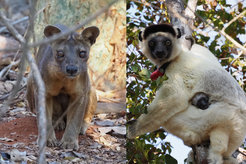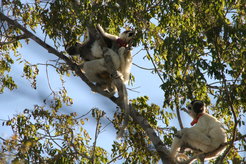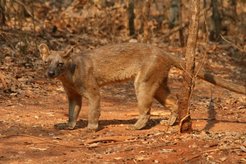Collective Ecology of Fossa and Sifaka
How do interactions with competitors and predators shape the collective dynamics of animal communities? All animals must navigate complex landscapes of risk and reward, but social species must accomplish this while balancing their own needs and preferences with those of their group-mates. How do individuals and groups ultimately integrate this conflict between risk versus reward to make decisions about when and where to go?

‘Probably the commonest death for many animals is to be eaten by something else’ - Charles Elton, 1927

Predation plays a major role in shaping the behavior and social dynamics of many group-living species. Even if predatory attacks are rare, perceived risk is likely a pervasive force shaping how animals interact with their environment and with each other. To better understand the collective dynamics of animal communities, we aim to map the behavior and interactions of sympatric predators and prey, revealing how together they shape their shared ecology. How does perceived predation risk vary across space? And are these perceptions objective? Once aware of the presence of a predator, how do prey animals transmit this information within and between groups? How does this information influence the behavioral choices of individuals, groups and the social neighborhood as a whole? And what are the consequences of this collective response for the predator and its movement decisions?

To answer these questions, we are studying the interaction between communities of predators and prey in Kirindy Mitea National Park, a dry, spiny forest in western Madagascar. Here, the lemur Verreaux’s sifaka (Propithecus verreauxi) is important prey for the fossa (Cryptoprocta ferox), the largest endemic carnivore still in Madagascar. Fossa typically occur at low population densities, but within Kirindy Mitea National Park, they occur at higher densities than in other forested areas of Madagascar. In this area, normally solitary fossa may hunt together to capture larger prey, acting as the primary predator of Verreaux’s sifaka. We, therefore, expect that fossa and sifaka movement decisions will be highly entwined, and that sifaka patterns of social interactions will be shaped by efforts to avoid predatory attacks. The extremes of the wet and dry season in Kirindy Mitea, and the energetic stress sifaka experience during the dry season allow us to investigate how they balance safety against the need to acquire and conserve resources. These two Malagasy species offer insight into how interactions between predator and prey shape the societies of each.
Further reading & Cited articles
Landscapes of Fear: Spatial Patterns of Risk Perception and Response (2019)
Behavioral decisions made under the risk of predation: a review and prospectus (1990)
Written by Bianca Schell, Scientific Writer & Web Editor, Department for the Ecology of Animal Societies
Photos provided by Rebecca Lewis














